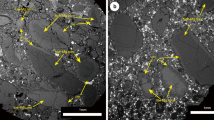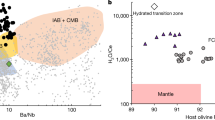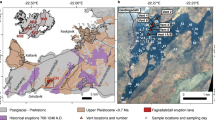Abstract
ESTIMATES of the composition of the Earth's mantle have been based on both geochemical and geophysical studies (refs 1–3). As might be expected, there are some discrepancies between the estimates particularly for Na2O and TiO2. Such discrepancies in part arise from uncertainties concerning the degrees of melting which many volcanics represent and, possibly, the restricted tectonic settings of the ultramafic nodules studied. High MgO basalts and ultramafic lavas, some of which have been termed komatiites4 occur among the Archaean volcanic rocks. They represent exceptionally high degrees of melting (up to 50% or more) of peridotite source regions. Potentially such volcanics may be used to make a precise estimate of the composition of their mantle source region. High MgO lavas are well preserved in the Archaean Belingwe greenstone belt of southern Rhodesia, where they form part of a sequence deposited unconformably on granitic crust5. We assume that the occurrence of pillow lavas in this sequence containing both skeletal olivine spinifex (Fo92.5 in a rock with 28% MgO, E. G. Nisbet, M. J. Bickle and A. Martin, unpublished) and skeletal olivine microphenocrysts indicates that these particular lavas have a composition close to that of the liquid.
This is a preview of subscription content, access via your institution
Access options
Subscribe to this journal
Receive 51 print issues and online access
$199.00 per year
only $3.90 per issue
Buy this article
- Purchase on Springer Link
- Instant access to full article PDF
Prices may be subject to local taxes which are calculated during checkout
Similar content being viewed by others
References
Harris, P. G., Hutchinson, R., and Paul, D. K., Phil. Trans. R. Soc., A271, 313 (1966).
Ringwood, A. E., Advances in Earth Sciences, 287 (Cambridge, Massachussetts, 1966).
Green, D. H., Geology, 3, 15 (1975).
Viljoen, M. J., and Viljoen, R. P., Spec. Publ. geol. Soc. S. Africa, 2, 55 (1969).
Bickle, M. J., Martin, A., and Nisbet, E. G., Earth planet. Sci. Lett., 27, 155 (1975).
Watson, E. B., Contrib. Miner. Petrol., 56, 119 (1976).
Green, D. H., Nicholls, I. A., Viljoen, M., and Viljoen, R. P., Geology, 3, 11 (1975).
Gast, P. W., Geochim. cosmochim. Acta, 32, 1057 (1968).
Hawkesworth, C. J., and O'Nions, R. K., J. Petrol, (in the press).
Schnetzler, C. C., and Philpotts, J. A., Geochim. cosmochim. Acta, 34, 331 (1970).
Hooker, P. J., O'Nions, R. K., and Pankhurst, R. J., Chem. Geol., 16, 181 (1975).
Arth, J. G., and Hanson, G. N., Geochim. cosmochim. Acta, 39, 325 (1975).
Author information
Authors and Affiliations
Rights and permissions
About this article
Cite this article
BICKLE, M., HAWKESWORTH, C., MARTIN, A. et al. Mantle composition derived from the chemistry of ultramafic lavas. Nature 263, 577–580 (1976). https://doi.org/10.1038/263577a0
Received:
Accepted:
Issue Date:
DOI: https://doi.org/10.1038/263577a0
This article is cited by
-
A comparative study of olivine and clinopyroxene spinifex flows from Alexo, abitibi greenstone Belt, Ontario, Canada
Contributions to Mineralogy and Petrology (1983)
-
Primary fractionation and secondary alteration within an Archean ultramafic lava flow
Contributions to Mineralogy and Petrology (1983)
-
Mantle composition derived from the composition of lherzolites
Nature (1980)
-
Ultrabasic magmas and high-degree melting of the mantle
Contributions to Mineralogy and Petrology (1977)
Comments
By submitting a comment you agree to abide by our Terms and Community Guidelines. If you find something abusive or that does not comply with our terms or guidelines please flag it as inappropriate.



